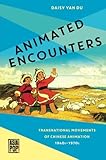Animated Encounters : Transnational Movements of Chinese Animation, 1940s-1970s / Daisy Yan Du; ed. by Allison Alexy.
Material type: TextSeries: Asia Pop!Publisher: Honolulu : University of Hawaii Press, [2019]Copyright date: ©2019Description: 1 online resource (276 p.) : 33 b&w illustrationsContent type:
TextSeries: Asia Pop!Publisher: Honolulu : University of Hawaii Press, [2019]Copyright date: ©2019Description: 1 online resource (276 p.) : 33 b&w illustrationsContent type: - 9780824877644
- 9780824877514
- 791.43340951 23
- NC1766.C6 .D8 2019
- online - DeGruyter
- Issued also in print.
| Item type | Current library | Call number | URL | Status | Notes | Barcode | |
|---|---|---|---|---|---|---|---|
 eBook
eBook
|
Biblioteca "Angelicum" Pont. Univ. S.Tommaso d'Aquino Nuvola online | online - DeGruyter (Browse shelf(Opens below)) | Online access | Not for loan (Accesso limitato) | Accesso per gli utenti autorizzati / Access for authorized users | (dgr)9780824877514 |
Frontmatter -- Contents -- Series Editor's Preface -- Acknowledgments -- Introduction: Animated Encounters: Chinese Animation in Motion -- 1. An Animated Wartime Encounter: Princess Iron Fan and the Chinese Connection in Early Japanese Animation -- 2. Mochinaga Tadahito and Animated Filmmaking in Early Socialist China -- 3. Inter/National Style and National Identity: Ink-Painting Animation in the Early 1960s -- 4. Animals, Ethnic Minorities, and Villains in Animated Film during the Cultural Revolution -- Epilogue: Television and Animated Encounters in Postsocialist China -- Appendix 1: Animated Films by Mochinaga Tadahito -- Appendix 2: Leaders of the Shanghai Animation Film Studio -- Appendix 3: Major Publications on Chinese Animation -- Notes -- Bibliography -- Index -- About the Author
restricted access online access with authorization star
http://purl.org/coar/access_right/c_16ec
China's role in the history of world animation has been trivialized or largely forgotten. In Animated Encounters Daisy Yan Du addresses this omission in her study of Chinese animation and its engagement with international forces during its formative period, the 1940s-1970s. She introduces readers to transnational movements in early Chinese animation, tracing the involvement of Japanese, Soviet, American, Taiwanese, and China's ethnic minorities, at socio-historical or representational levels, in animated filmmaking in China. Du argues that Chinese animation was international almost from its inception and that such border-crossing exchanges helped make it "Chinese" and subsequently transform the history of world animation. She highlights animated encounters and entanglements to provide an alternative to current studies of the subject characterized by a preoccupation with essentialist ideas of "Chineseness" and further questions the long-held belief that the forty-year-period in question was a time of cultural isolationism for China due to constant wars and revolutions.China's socialist era, known for the pervasiveness of its political propaganda and suppression of the arts, unexpectedly witnessed a golden age of animation. Socialist collectivism, reinforced by totalitarian politics and centralized state control, allowed Chinese animation to prosper and flourish artistically. In addition, the double marginality of animation-a minor art form for children-coupled with its disarming qualities and intrinsic malleability and mobility, granted animators and producers the double power to play with politics and transgress ideological and geographical borders while surviving censorship, both at home and abroad.A captivating and enlightening history, Animated Encounters will attract scholars and students of world film and animation studies, children's culture, and modern Chinese history.
Issued also in print.
Mode of access: Internet via World Wide Web.
In English.
Description based on online resource; title from PDF title page (publisher's Web site, viewed 02. Mrz 2022)


